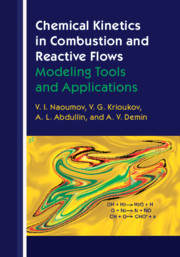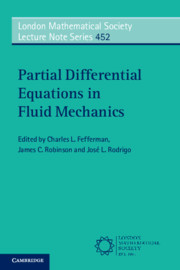3653 results in ebooks in fluid mechanics
Reviews
-
- Book:
- Chemical Kinetics in Combustion and Reactive Flows
- Published online:
- 16 August 2019
- Print publication:
- 22 August 2019, pp i-ii
-
- Chapter
- Export citation
6 - Models of Droplet Evaporation in Gas Flow
- from Part II - Mathematical Modeling of Selected Typical Modes of Combustion
-
- Book:
- Chemical Kinetics in Combustion and Reactive Flows
- Published online:
- 16 August 2019
- Print publication:
- 22 August 2019, pp 262-280
-
- Chapter
- Export citation
References
-
- Book:
- Chemical Kinetics in Combustion and Reactive Flows
- Published online:
- 16 August 2019
- Print publication:
- 22 August 2019, pp 397-417
-
- Chapter
- Export citation

Leaf Optical Properties
-
- Published online:
- 19 August 2019
- Print publication:
- 05 September 2019

Chemical Kinetics in Combustion and Reactive Flows
- Modeling Tools and Applications
-
- Published online:
- 16 August 2019
- Print publication:
- 22 August 2019

Partial Differential Equations in Fluid Mechanics
-
- Published online:
- 15 August 2019
- Print publication:
- 27 September 2018
Index
-
- Book:
- MHD Waves in the Solar Atmosphere
- Published online:
- 15 July 2019
- Print publication:
- 18 July 2019, pp 501-508
-
- Chapter
- Export citation
14 - Solar Applications of MHD Wave Theory
-
- Book:
- MHD Waves in the Solar Atmosphere
- Published online:
- 15 July 2019
- Print publication:
- 18 July 2019, pp 434-488
-
- Chapter
- Export citation
9 - Gravitational Effects
-
- Book:
- MHD Waves in the Solar Atmosphere
- Published online:
- 15 July 2019
- Print publication:
- 18 July 2019, pp 248-280
-
- Chapter
- Export citation
References
-
- Book:
- MHD Waves in the Solar Atmosphere
- Published online:
- 15 July 2019
- Print publication:
- 18 July 2019, pp 489-500
-
- Chapter
- Export citation
8 - Connection Formulas
-
- Book:
- MHD Waves in the Solar Atmosphere
- Published online:
- 15 July 2019
- Print publication:
- 18 July 2019, pp 207-247
-
- Chapter
- Export citation
6 - Magnetic Flux Tubes
-
- Book:
- MHD Waves in the Solar Atmosphere
- Published online:
- 15 July 2019
- Print publication:
- 18 July 2019, pp 139-181
-
- Chapter
- Export citation
Dedication
-
- Book:
- MHD Waves in the Solar Atmosphere
- Published online:
- 15 July 2019
- Print publication:
- 18 July 2019, pp v-vi
-
- Chapter
- Export citation
Preface
-
- Book:
- MHD Waves in the Solar Atmosphere
- Published online:
- 15 July 2019
- Print publication:
- 18 July 2019, pp xvii-xx
-
- Chapter
- Export citation
5 - Magnetic Slabs
-
- Book:
- MHD Waves in the Solar Atmosphere
- Published online:
- 15 July 2019
- Print publication:
- 18 July 2019, pp 102-138
-
- Chapter
- Export citation
4 - Surface Waves
-
- Book:
- MHD Waves in the Solar Atmosphere
- Published online:
- 15 July 2019
- Print publication:
- 18 July 2019, pp 83-101
-
- Chapter
- Export citation
12 - Damping
-
- Book:
- MHD Waves in the Solar Atmosphere
- Published online:
- 15 July 2019
- Print publication:
- 18 July 2019, pp 360-396
-
- Chapter
- Export citation
11 - Thin Flux Tubes: The Kink Mode
-
- Book:
- MHD Waves in the Solar Atmosphere
- Published online:
- 15 July 2019
- Print publication:
- 18 July 2019, pp 311-359
-
- Chapter
- Export citation
Frontmatter
-
- Book:
- MHD Waves in the Solar Atmosphere
- Published online:
- 15 July 2019
- Print publication:
- 18 July 2019, pp i-iv
-
- Chapter
- Export citation
10 - Thin Flux Tubes: The Sausage Mode
-
- Book:
- MHD Waves in the Solar Atmosphere
- Published online:
- 15 July 2019
- Print publication:
- 18 July 2019, pp 281-310
-
- Chapter
- Export citation
